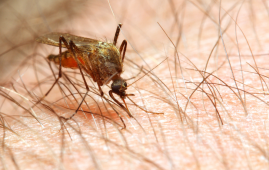

Researchers looked at the connection between nighttime light exposure outside and the frequency of Alzheimer’s disease (AD), a progressive brain ailment that causes memory loss and cognitive decline, in the US. Their findings were published in the Frontiers of Neuroscience journal.
Context
Before gas and electric lighting became common in the 18th and 19th centuries, much of history’s light came from fire-based sources. Artificial lighting is widely used nowadays, which improves safety and convenience, but too much nighttime light, sometimes referred to as light pollution, obscures natural celestial light and is hazardous to human health.
It has been connected to depression, obesity, sleep disturbances, and maybe neurodegenerative illnesses like Alzheimer’s. To fully comprehend the potential role that evening light exposure plays in Alzheimer’s disease development and neurodegeneration, more research is required.
About the Study
The current study examined the association between nocturnal light exposure and the prevalence of AD in both sexes using de-identified Medicare data from 2012 to 2018.
The Centers for Medicare and Medicaid Services (CMS) provided the data, which were limited to fee-for-service beneficiaries who were over 65, people with specific disabilities, and people who had end-stage renal illness. Geographic variations in the prevalence of AD were influenced by differences in diagnostic procedures and healthcare resources.
The Behavioral Risk Factor Surveillance System (BRFSS) of the CDC, which monitors self-reported adult obesity, provided the obesity statistics.
Data on nighttime light exposure were obtained from the National Polar-orbiting Partnership and Visible Infrared Imaging Radiometer Suite (VIIRS) of the National Aeronautics and Space Administration (NASA). Distribution Function for Bidirectional Reflectance
Over the course of the study, radiance levels and composites of (NPP Lunar BRDF)-Adjusted Nighttime Lights were averaged for each state and county.
Analysis of Variance (ANOVA) and correlation analysis were used in statistical analyses to assess the association between the prevalence of AD and evening light exposure. To take into consideration repeated measures at the county and state levels, a linear mixed model was used.
The model also incorporated biological markers such as atrial fibrillation, diabetes, and obesity, as well as covariates like race, age, sex, and heart issues (an irregular, rapid heartbeat that can cause strokes and heart problems).
Study findings
Using satellite data on nighttime light exposure and Medicare data from 2012 to 2018, the association between average nightly light intensity and AD prevalence was investigated. States were split into five groups, ranging from the darkest to the brightest, based on their average nighttime light intensity.
A statistical study of both groups showed a substantial difference in the prevalence of AD, with higher prevalence states being brighter. This correlation was further supported by a Pearson correlation study, which showed a positive correlation between the prevalence of AD and evening light intensity nationwide. This relationship was valid for both people over and under 65.
The results were confirmed when the data were analyzed year over year and the same significant correlation between evening light and AD prevalence was found. A linear mixed model that took into account all participants as well as subgroups separated by age, sex, and race revealed a substantial correlation between nocturnal light intensity and the prevalence of AD.
For example, among Native Americans and other ethnic groups, the link was especially strong. Even when covariates including alcohol misuse, depression, heart failure, chronic kidney disease, and obesity were taken into consideration, the effect of nocturnal light exposure persisted.
However, light exposure was not as substantially related with the prevalence of AD as other co-variates, such as atrial fibrillation, diabetes, and stroke.
There was also an investigation done on counties, which are typically more homogeneous than entire states. By combining county-level nighttime light intensity with Medicare Chronic Conditions data, the association between nighttime light intensity and AD prevalence was evaluated in the largest city in each state.
The correlation between nighttime light and the prevalence of AD at the county level was validated by this investigation. The prevalence of AD was considerably higher in counties with the highest evening light intensity than in those with the lowest.
Additionally, correlation studies showed that light intensity and the prevalence of AD were positively correlated in both those over 65 and those under 65.
The strong correlation between nocturnal light exposure and the prevalence of AD at the county level was further corroborated by a linear mixed-effects model.
This association held true for all age categories, with people under 65 showing more high benefits. The results at the county level corroborated those at the state level, adding to the body of evidence supporting the hypothesis that evening light exposure and the prevalence of AD are positively correlated.
Conclusion
In summary, the study discovered that between 2012 and 2018, a higher average nighttime light intensity, or light pollution, was associated with a higher prevalence of AD, affecting most age and racial groups as well as both sexes.
While the correlation between nighttime light exposure and AD was not as great as it was for illnesses like diabetes and stroke, it was still higher than for risk factors including obesity, alcohol misuse, and depression. Individuals under 65 showed heightened sensitivity to exposure to light.
For more information: Outdoor nighttime light exposure (light pollution) is associated with Alzheimer’s disease, Frontiers of Neuroscience, https://doi.org/10.3389/fnins.2024.1378498
more recommended stories
 36-Week Pre-eclampsia Screening May Reduce Term Risk
36-Week Pre-eclampsia Screening May Reduce Term RiskA New Preventive Strategy for Term.
 Cardiovascular Risk and Sudden Cardiac Death in Diabetes
Cardiovascular Risk and Sudden Cardiac Death in DiabetesRising Sudden Cardiac Death (SCD) Risk.
 Poor Kidney Function and Alzheimer’s Biomarkers Explained
Poor Kidney Function and Alzheimer’s Biomarkers ExplainedPoor kidney function may influence levels.
 Perinatal Mental Health Challenges Highlighted in New Study
Perinatal Mental Health Challenges Highlighted in New StudyMental Health Challenges in New Parents:.
 Walking Speed Before Hip Replacement Predicts Recovery
Walking Speed Before Hip Replacement Predicts RecoveryNew Evidence Points to a Simple,.
 Neuroblastoma Drug Combo Extends Survival in Models
Neuroblastoma Drug Combo Extends Survival in ModelsA Promising Shift in High-Risk Neuroblastoma.
 How Soybean Oil Impacts Weight Gain and Metabolism
How Soybean Oil Impacts Weight Gain and MetabolismWhy Soybean Oil May Affect Metabolism.
 New Malaria Prevention Insights From African Biostatistics
New Malaria Prevention Insights From African BiostatisticsHow New Data Is Reframing Malaria.
 Coffee and Cognitive Function: Evidence Review
Coffee and Cognitive Function: Evidence ReviewA new narrative review in Cureus.
 World Summit Outlines Core Principles for Healthy Longevity
World Summit Outlines Core Principles for Healthy LongevityWhy Healthy Longevity Demands a New.

Leave a Comment